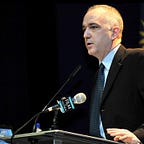Part 1; Tuesday @ 11am is The Best Time to Make News.
I have been in countries where news stations, newspapers and bloggers are told what to cover. It is a bland and troubling thing to witness.
In democracies, just because something is important to you, or virtuous or cutting-edge, doesn’t mean it’s news, because we have to compete to make news. We have to hustle for clicks and eyeballs because it is a market place, or what some dub the Attention Economy.
I share this T@11 tool to help you win that competition. Through 30 states over 3 presidential campaigns, I have coordinated media events from early-state house parties to arenas and then White House press events.
We are going to focus on earned media, or simply put; getting your story, cause or product into the churning, national news conversation that touches tens of millions of people a day. Here is the ROI; each newspaper article, TV news story or on-line mention is advertising you didn’t pay for, so if you get a 60 second story on the nightly news, how much does a 60 second ad on that network cost? There’s a 1,000 word article about your event and it has been clicked 175,000 times. How much is a 1,000 word ad in that newspaper or on that site?
A couple no fly-zones; weekends and evenings are out. Often when bad news has to get released by a company or an elected official it mysteriously happens at 4pm on a Friday. That is because Friday afternoon to Monday morning is a news graveyard. Same with evenings. Unless you are announcing a trillion dollar grant to the Institute for Studying Cute Babies, you ain’t getting coverage at 7 or 8pm or on Saturday or Sunday. Period.
Tuesday allows you to force multiply prep, execution and amplification. In terms of preparation, 10 days out from your event or announcement you send a press advisory out to all your targeted outlets, which is the news equivalent of a wedding’s Save the Date. Last Thursday you sent it again with the names of the people who will be speaking, 2–3 sentences from each of their draft remarks, and a more detailed explanation of what the value of the product is or purpose of the coalition to be announced. You will send that out again Tuesday morning. On Monday you pump the event one last time through things like placing an op-ed from the CEO in an influential publication, populate highly trafficked blogs with content from consumers, clients or allies, and use social media to start framing an entire week around the news you intend to make Tuesday at 11am.
Second reason; 11am is easy to cover. It is well before reporters have to file and TV crews have to edit their daily pieces, but it is not so early that airwaves are saturated with the morning’s news and what happened yesterday. The window to build proactive news is roughly 10am-3pm or so, which is why you often see the key messaging event of any White House happen in that window. I would not go later than that. By 4pm stories need to be in the can or at least in editing or final draft, and video footage by then is being edited. No TV station is going to cover a story that happens one hour before broadcast, unless it is so pressing they have a crew on-site and go live.
The geographic complement to this point; make it easy to cover. You want a downtown location or something not more than 5–10 miles outside of downtown. Every mile you ask the media to travel is a mile that decreases the likelihood that they will cover your event. Community centers allow non-partisan events to happen in their halls, and Chambers of Commerce, Rotaries and veterans organizations often have inexpensive function rooms. Last resorts are the conference room of a friendly law firm or coalition partner, or the bland but dependable hotel conference room. Proximity, parking, power, rest rooms are key, as is ADA compliance so all are able to attend. Helpful here is to have some video clips on a thumb drive or posted on-line, and this is called b-roll. B-roll demonstrates the human angle of your issue, so kids in a classroom, a farm functioning, cars on a highway, all are helpful visual context for news outlets. Also plan to stream your event live on the platform most used by your target demographic.
Last, Tuesday allows for 3.5 days of amplification. Your news making event is the 50 yard line, not the end zone. There is just as much work to do after as before, and there are multiple layers of value. For your supporters, funders or coalition members, you send an email out on Wednesday with clips from the news coverage you generated on Tuesday. You strategically have more op-eds lined up for key publications on Wednesday and Thursday, you prepare allies and friends with talking points for popular drive-time radio shows, put together a roughly edited synopsis of your news making event for people to share on social, and make sure you have translations if necessary so you don’t leave anyone out. You can also build an Ask or Call to Action into your amplification, like sign this petition, share this article, post this study. Maybe plan a Facebook or Instagram live session for Thursday afternoon where you share some of the clips and coverage in an interactive setting, and always make sure that you are driving your message on the very platforms your target audience uses in their daily lives.
All these tools and more can help frame an entire week around Tuesday 11am and increase your chances of getting people’s attention. It is only when you have their attention that you have any chance at persuasion.
